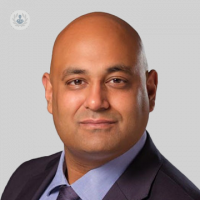Considering a tummy tuck? Here's your informative need-to-know guide
Escrito por:With regards to removing excess skin and fat from the abdominal area, an abdominoplasty (tummy tuck) is as effective as procedures come. In our latest article, esteemed consultant plastic, reconstructive and aesthetic surgeon, Mr Hrsikesa Sharma, provides us with an all-you-need-to-know informative guide for those who may be considering undergoing the highly popular abdomen-tightening procedure.

What is an abdominoplasty operation?
An abdominoplasty or tummy tuck operation is a procedure performed in order to improve the overall appearance of one’s abdomen. It involves removing excess skin and fat in the lower part of the abdomen that is resistant to weight loss. In some patients, tightening of the abdominal muscles is also required.
Who is an ideal candidate for an abdominoplasty operation?
After pregnancy or weight loss, it is common for the skin of the abdomen to stretch and not shrink back. Diet and exercise are unable to remove these lower abdominal stretch marks that can appear and bother some patients.
Often, a bulge in the lower abdomen is present, which can overhang clothes or bikini bottoms. This can affect confidence and can sometimes make one reluctant to wear certain clothes or go swimming.
The ideal candidate for an abdominoplasty surgical procedure is someone who may feel uncomfortable about their abdomen or someone who is self-conscious about what their abdomen looks like. A candidate who falls into this category will greatly benefit from this procedure.
What does the operation involve?
The operation is performed under general anaesthetic (the patient is asleep) and takes, on average, between three to four hours, and requires two to three nights of overnight stay in hospital. During the surgery, drain tubes are inserted and these are usually removed a day or two after the surgery has taken place. Dressings are then usually placed for two weeks and a support garment/binder is recommended for six weeks following the operation.
What are the different types of abdominoplasty procedures and how are they performed?
Different types of abdominoplasty surgeries may be performed depending on individual patient needs and the condition of their abdomen. These include:
- Standard abdominoplasty: within a standard abdominoplasty procedure, an incision (small cut) is usually made in a curve from one hip to the other, going down just above the pubic area. Excess skin and fat are removed between the pubic area and the umbilicus (belly button). Then, the skin above the umbilicus is raised as a flap to facilitate closure and tightening of the abdomen. A small cut is made in this flap to reposition the umbilicus or sometimes a new umbilicus is created.
- Fleur-de-lis abdominoplasty: this is usually indicated if there is a substantial amount of excess skin hanging downwards and around your abdomen, or if there is quite a lot of excess above your umbilicus. The fleur-de-lis abdominoplasty procedure is similar to a standard abdominoplasty with the addition of an extended incision made vertically in the midline from the umbilicus to just below the breast bone. This facilitates the removal of the excessive skin and fat that may have caused a bulge in the midline above the umbilicus.
- Mini abdominoplasty: this is usually indicated for women who have a little bit of excess skin above the pubic bone and/or a high umbilicus.
- Lower body lift/belt lipectomy: a lower body lift/belt lipectomy is usually required for weight loss patients either through exercise/diet or post bariatric surgery. In addition to a standard or fleur-de-lis abdominoplasty, excess skin and fat from the lower back is also removed through an incision in this area. This procedure may be staged.
What can patients do to help improve the success of their operation?
I always advise my abdominoplasty patients to stop smoking at least six weeks before and after surgery. Of course, it is also vital to maintain a healthy weight, as there are higher risks of developing complications if you are overweight.
Some herbal supplements can lead to thinning of the blood and potentially increase a patient’s risk of developing abdominoplasty complications. Therefore, with this in mind, I typically advise patients to stop taking these six to eight weeks prior to undergoing an abdominoplasty.
What are the main potential complications that can occur as a result of abdominoplasty surgery?
In the majority of cases, this operation is carried out very successfully with excellent cosmetic results. However, as with any surgical procedure, there is a small chance of patients suffering from or experiencing some side effects or complications. This is a list of potential complications that patients considering undergoing an abdominoplasty should be aware of:
- bleeding
- wound infection
- wound breakdown
- scarring
- asymmetry/cosmetic problems
- developing a lump or fat necrosis
- seroma
- deep vein thrombosis (DVT)
- pulmonary embolus
Mr Hrsikesa Sharma is an extremely reputable consultant plastic, reconstructive and aesthetic surgeon who possesses expert knowledge when it comes to abdominoplasty. If you are considering undergoing an abdominoplasty procedure, be sure to check out Mr Sharma's Top Doctors profile today to book an appointment with him.


